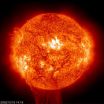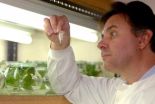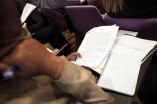(Press-News.org) Massive waves in giant magnetic holes on the surface of the Sun have been discovered for the first time by solar scientists from the University of Sheffield and Queen's University Belfast, something that will bring experts a step closer to unlocking the secrets of the Sun.
The Sun is interwoven by a complex network of magnetic field lines that are responsible for a large variety of fascinating features that can be seen in the solar atmosphere. Large, dark regions, which look like holes on the Sun's surface, mark out areas where the magnetic field breaks through from the Sun's deep, boiling interior and rises into the very hot solar atmosphere, which is over a million degrees. The largest of these dark regions are often called sunspots and have been studied since their discovery from as early as 364 BC.
Led by Professor Robertus von Fay-Siebenburgen, Head of the Solar Physics and Space Plasma Research Centre (SP2RC) at the University of Sheffield, the team studied a magnetic region of the Sun much smaller than a sunspot, however its size was still many times greater than the size of the UK.
Their research, which was published this week in Astrophysical Journal, has shown that the magnetic hole they observed, which is also known as a pore, is able to channel energy generated deep inside the Sun, along the magnetic field to the Sun's upper atmosphere. The magnetic field emerging through the pore is over 1,000 times stronger than the magnetic field of the Earth.
The energy being transported is in the form of a very special form of waves, known as 'sausage waves' which the scientists were able to observe using a UK-built solar imager known as ROSA (Rapid Oscillations of the Solar Atmosphere), which was designed by Queen's University Belfast and is in operation at the Dunn Solar Telescope, Sacramento Peak, USA. This is the first direct observation of 'sausage waves' at the solar surface. The magnetic hole is seen to increase and decrease in size periodically which is a characteristic feature of the 'sausage wave.'
The team of experts, including Dr Richard Morton from the University of Sheffield, as well as Professor Mihalis Mathioudakis and Dr David Jess from Queen's University Belfast, hope these giant magnetic holes will play an important role in unveiling the longstanding secrets behind solar coronal heating.
This is because the solar surface has a temperature of a few thousand degrees but the solar corona - the outermost, mysterious, and least understood layer of the Sun's atmosphere - is heated to temperatures often a thousand times hotter than the surface. Why the temperature of the Sun's atmosphere increases as we move further away from the centre of energy production, which lies under the surface, is a great mystery of astrophysics. The findings, which demonstrate the transfer of energy on a massive scale, offer a new explanation for this puzzle.
The team now hope to use further similar solar images from ROSA to understand the fine substructure of these massive magnetic holes by reconstructing the images to view what is inside the holes.
Professor Robertus von Fay-Siebenburgen, said: "This is a fascinating new discovery in line with a number of discoveries made in recent years by the team. It is the first time that 'sausage waves' have been detected in the Sun with such detail. Analysing these waves may bring us closer to understanding the physical mechanisms in the atmosphere of a star.
"I am very proud that such talented young researchers like Richard and Dave have shown such a serious commitment in bringing us closer to unveiling the secrets of the Sun. We're also very pleased that Professor Keenan and the Queen's University Belfast solar team were able to build such a wonderful instrument that allows us to make unprecedented observations with relatively low costs."
The news comes as part of the University of Sheffield's unique venture entitled Project Sunshine, led by the Faculty of Science. SP2RC plays a key role in Project Sunshine, which aims to unite scientists across the traditional boundaries in both the pure and applied sciences to harness the power of the Sun and tackle the biggest challenge facing the world today: meeting the increasing food and energy needs of the world´s population in the context of an uncertain climate and global environment change.
INFORMATION:
Notes to editors:
To view the research paper entitled 'Observations of Sausage Modes in Magnetic Pores' visit: http://iopscience.iop.org/2041-8205/729/2/L18
Project Sunshine, led by the Faculty of Science at the University of Sheffield aims to unite scientists across the traditional boundaries in both the pure and applied sciences to harness the power of the Sun and tackle the biggest challenge facing the world today: meeting the increasing food and energy needs of the world´s population in the context of an uncertain climate and global environment change. It is hoped that Project Sunshine will change the way scientists think and work and become the inspiration for a new generation of scientists focused on solving the world´s problems. The first international Project Sunshine conference, Shine, will take place from 13-14 September 2011 at Sheffield City Hall. For more information, visit: http://shine.sheffield.ac.uk/
For further information please contact: Shemina Davis, Media Relations Officer, on 0114 2225339 or email shemina.davis@sheffield.ac.uk
To view this news release and images online, visit http://www.shef.ac.uk/mediacentre/2011/1849-sun-waves-magnetic-solar.html
To read other news releases about the University of Sheffield, visit http://www.shef.ac.uk/mediacentre/
Solar experts detect waves in giant magnetic holes the size of the UK
2011-02-28
ELSE PRESS RELEASES FROM THIS DATE:
New path to water efficient seeds opens as TIP pips PIP as water gatekeeper
2011-02-28
Research by University of Warwick's School of Life Sciences has opened up a new path to produce water efficient seeds that will be a significant tool to cope with drought resistance, and ensure global food security. The research not only provides the best map to date of the key protein that appears to be the principal gateway for water intake during seed germination - it also actually provides the right map as it appears much of the research to date was focussed on a much less relevant protein.
The research team led by Dr Lorenzo Frigerio looked at two proteins that ...
Qualified Latin American immigrants earn less than similarly qualified Spaniards
2011-02-28
A study by the University of Salamanca (USAL) has looked into how salaries would differ if immigrants were paid in the same way as Spanish workers according to education and experience. The results show that, in higher salary ranges, Latin American immigrants earn around 20% less than their Spanish counterparts.
"In this paper we analysed the salary differences between Spanish workers and Latin American or Caribbean immigrants in 2006", José Ignacio Antón, a researcher at the USAL and co-author of the study, which has been published in the Journal of Applied Economics, ...
IOF calls for action following release of Eastern European & Central Asian Regional Audit
2011-02-28
A newly published audit report by the International Osteoporosis Foundation (IOF) consolidates information on the status and burden of osteoporosis in 21 countries of Eastern Europe and Central Asia, including the Russian Federation. The landmark report 'Eastern European & Central Asian Regional Audit – Epidemiology, Costs & Burden of Osteoporosis in 2010' shows alarming projections and reveals the poor status of post-fracture care and osteoporosis management in the region.
IOF President John Kanis called for immediate action, asking all stakeholders in the region to ...
Lack of health insurance limits hepatitis C patients' access to latest antiviral therapy
2011-02-28
New research has determined that patients in the U.S. with hepatitis C virus (HCV) are twice as likely to not have health insurance coverage compared with those without the disease. In fact researchers found only a third of HCV infected Americans have access to antiviral therapy; the remaining are either uninsured or not candidates for therapy due to treatment contraindications. Details of this study are published in the March issue of Hepatology, a peer-reviewed journal of the American Association for the Study of Liver Diseases (AASLD).
HCV is the most common cause ...
Collisions of protein machines cause DNA replication derailment
2011-02-28
Scientists have published results that will forever change the way researchers view the interplay between gene expression, DNA replication and the prevention of DNA damage.
DNA damage, if not kept in check, can lead to many problems including cancers. Researchers, funded by the Biotechnology and Biological Sciences Research Council (BBSRC) and the Wellcome Trust and working at The University of Nottingham, have shown that the process of replication is even riskier than originally thought. This new information is published today (24 February) in the journal Nature.
Lead ...
A glove to prevent premature birth
2011-02-28
Changes to the microbiological equilibrium in the female genital tract can lead to obstetric complications. In the current issue of the Deutsches Ärzteblatt International (Dtsch Arztebl Int 2011; 108[6]: 81), the working group around Eva-Maria Bitzer investigates a method of screening for such changes.
Among the complications in question are low birthweights and preterm deliveries. To avoid these, in a model project running from 2004 to 2006, pregnant women were asked to self-test their vaginal pH. They were provided with test gloves and asked to carry out the ...
Hospital infections and multidrug-resistant pathogens
2011-02-28
Infections are among the most frequent complications of a stay in hospital and raise the complication and mortality rates. Calculations based on data from the Hospital Infection Surveillance System (Krankenhaus-Infektions-Surveillance-System, KISS) showed an incidence of almost 60 000 newly acquired infections per year in intensive care units in Germany. This is the conclusion reached by Christine Geffers and her coauthor in the current issue of Deutsches Ärzteblatt International (Dtsch Arztebl Int 2011; 108 (6):87-93).
KISS is a quality assurance tool for hospitals. More ...
Language patterns are roller-coaster ride during childhood development
2011-02-28
Why, and when, do we learn to speak the way that we do? Research from North Carolina State University on African-American children presents an unexpected finding: language use can go on a roller-coaster ride during childhood as kids adopt and abandon vernacular language patterns.
"We found that there is a 'roller-coaster effect,' featuring an ebb and flow in a child's use of vernacular English over the course of his or her language development," says Dr. Walt Wolfram, William C. Friday Distinguished University Professor of English Linguistics at NC State and co-author ...
Home urine test measures insulin production in diabetes
2011-02-28
A simple home urine test has been developed which can measure if patients with Type 1 and Type 2 diabetes are producing their own insulin. The urine test, from Professor Andrew Hattersley's Exeter-based team at the Peninsula Medical School, replaces multiple blood tests in hospital and can be sent by post as it is stable for up to three days at room temperature. Avoiding blood tests will be a particular advantage for children.
The urine test measures if patients are still making their own insulin even if they take insulin injections. Researchers have shown that the test ...
Low vitamin D levels linked to allergies in kids
2011-02-28
February 24, 2011 ─ (BRONX, NY) ─ A study of more than 3,000 children shows that low vitamin D levels are associated with increased likelihood that children will develop allergies, according to a paper published in the February 17 online edition of the Journal of Allergy and Clinical Immunology. Researchers from Albert Einstein College of Medicine of Yeshiva University headed the study.
Researchers looked at the serum vitamin D levels in blood collected in 2005-2006 from a nationally representative sample of more than 3,100 children and adolescents and 3,400 ...


